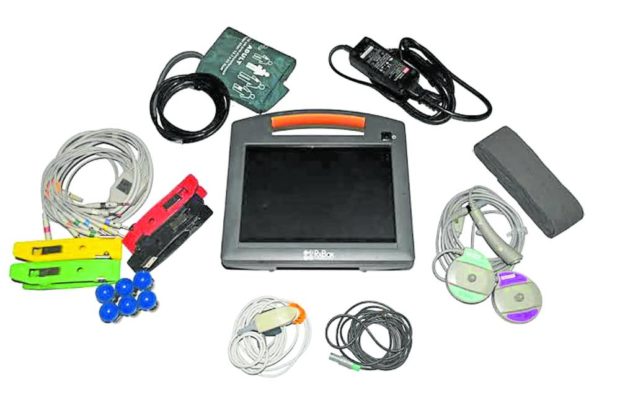
MULTIPURPOSE DEVICE The RxBox and its implements were developed by the Department of Science and Technology (DOST) and the University of the Philippines for areas lacking access to medical aid. —PHOTO FROM DOST
TAGBILARAN, Bohol, Philippines — A pregnant woman in Batuan, Bohol province, was rushed last week to the town’s health center—a one-story building run by a team of 16 medical workers.
She arrived just in time, because, according to physician Mark Johnuel Duavis, if she had come earlier, the clinic’s staff wouldn’t have been able to do much except to send her to a hospital more equipped to handle complex cases.
Like most rural facilities, the health center in Batuan — a fifth-class municipality 51 kilometers away from this provincial capital — didn’t have enough diagnostic equipment.
Portable aid
“So the most we can do is interview the patient, check them, and then that’s that,” Duavis said.
“It’s like we’re diagnosing while blind,” he added. “The most we can do is referrals.”
But help came last month when the Department of Science and Technology (DOST) gave the health center a portable box-like device.
Developed by physicians and engineers from the University of the Philippines (UP), the RxBox could do wonders which Batuan’s health workers thought could only be achieved by more sophisticated machines — such as measure the heart’s electrical signals, the oxygen level of the lungs, a baby’s heart rate.
Through that box, they learned that the pregnant woman was quite critical, as she was hypertensive and her baby was running out of oxygen.
They gave her a dose of magnesium sulfate before sending her to a district hospital for a cesarean operation.
Duavis believes their intervention helped save the baby’s life.
“Now we are able to give initial management before we refer [a patient],” he said.
“That’s the golden period we can use to increase [the] survival rate…. It’s very revolutionary in a primary care setting,” he added.
Multipurpose device
The RxBox, as it is called, was developed precisely for the purpose of combining several diagnostic tools to detect common medical problems.
The instrument has a blood pressure monitor, a pulse oximeter, an electrocardiogram (ECG), a fetal heart monitor and a maternal tocometer built around a touchscreen tablet.
These are functions “originally intended for the emergency room,” said Dr. Portia Grace Marcelo, one of the project’s team leaders.
“But I wanted these tools available at the rural level where they can improve public health,” she added.
The DOST and UP worked together for about seven years to develop this device, which simultaneously records multiple measurements before transmitting the data to the government’s central health tracking system.
Emelita Bagsit, DOST regional director for the Calabarzon region, said they had to fine-tune the RxBox in many field tests while training hundreds of personnel and choosing the sites where it could be most useful.
On Friday, they finally fulfilled their goal of distributing close to 1,000 RxBoxes in far-flung towns across the country.
In a country where six in 10 Filipinos die without seeing a doctor, this technology “can turn the tide for universal health care,” said Jaime Montoya, chief of the DOST’s Philippine Council for Health and Research Development.
Limitations
The RxBox also has its limitations, said Luis Sison, a professor at UP’s College of Engineering. It cannot, for example, do specialized diagnoses.
But “what it lacks in terms of sophistication, it more than makes up [for] in terms of integration,” he said.
Duavis said the instrument can also help save people money.
Most rural health centers, for example, often do not have ECGs—a “very basic procedure” especially since chest pain is such a common case, he said.
“Before, we would have had to refer them to a hospital where they need[ed] to pay P200 to P250—money they could have spent on medicine or travel costs,” Duavis said, adding that now the box is free.
When the pandemic hit the country in 2020, the RxBox became useful for telemedicine, Montoya said. In areas where there were no doctors, medical workers would just send their data via telemedicine to a remote physician for diagnosis.
According to Jay Chavez, chief operating officer of Ionics Engineering which manufactured the RxBox, the device also works in areas without internet.
Some devices use radio waves or SMS to transmit data.
“Whatever is available in that area, we can use technology that can be relevant,” Chavez said.
For Science and Technology Secretary Renato Solidum Jr., the RxBox brings his agency closer to its goal of providing sustainable health care in communities.
The RxBox has a steep price of P365,000, which also covers training for workers, communications infrastructure for the device and other features. But it’s a practical expense, considering that it can be used for many patients.
Solidum said the DOST has subsidized the manufacture of 1,000 units, adding that these have been deployed across the country.
He said the DOST hopes to convince the local governments to buy the instrument for their barangays.
“We need to show that this is really useful,” he said. “Once they appreciate this, other [instruments] can be shared with them.”
“Universal health care needs to happen sooner rather than later,” he said.